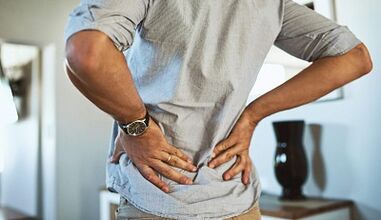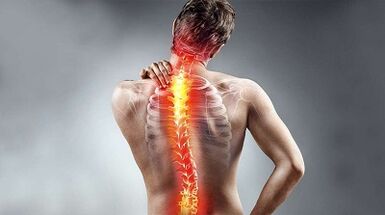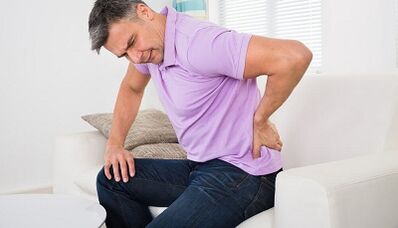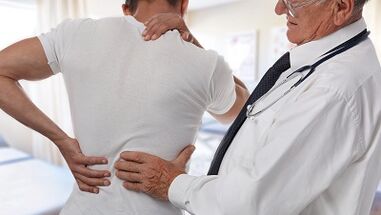
Back pain can occur at any age, but more often it occurs between 35 and 55 years.The spine pain is associated with how our bones, muscles, intervertebral discs, ligaments, tendons and nerves work.
The pain in the spine can be caused by problems with the vertebrae, the discs between them, the ligaments around the spinal column and the discs, the spinal cord and the nerves, the back muscles, the internal organs in the abdominal and pelvic areas.In addition, aorta diseases, tumors in the chest and inflammation of the spine in the upper back can be the cause of the pain in the upper back.
Risk factors
The presence of risk factors increases the probability of developing a state.For example, obesity significantly increases the risk of second type diabetes.
The following factors are associated with an increased risk of back pain.
- office work;
- work associated with constant stress;
- Pregnancy - pregnant women often suffer from pain in the spine;
- sedentary lifestyle;
- age;
- depression;
- obesity/excess weight;
- smoke;
- heavy physical exercises;
- Heavy physical work.
Signs and symptoms of back pain
The symptom is what the patient feels, while the doctor can see the mark.For example, pain is a symptom, while a rash is a sign.
The main symptom of spine pain is pain in any part of the back.Sometimes the pain extends to buttocks and legs or shoulders and arms.
It is necessary to contact the doctor immediately if the pain in the spine accompanies one of the following signs:
- weight loss;
- high temperature (fever);
- Back pain is not raised after rest;
- painful pain;
- lowering of pain under the knee;
- the presence of fresh injuries to the spine;
- incontinence in the urine (also a small portion);
- Difficulty with urination - urine is difficult;
- Facal incontinence - loss of control over the defecation process;
- numbness in the field of genitals;
- numbness in the anus;
- Numbness in the buttocks.

Request the advice of a specialist if you are one of these groups:
- people under the age of 22 years of 55 years;
- patients who have hired steroids for several months;
- patients with cancer;
- patients who once had cancer;
- Patients with low immunity.
The causes of back pain
The human vertebral column is a complex structure consisting of muscles, ligaments, tendons, records and bones.The intervertebral discs are located between each vertebrae pair and work as friction shock absorbers.The problems with one of these components can lead to pain in the spine.In some cases, the causes of pain cannot be established.
Elongation
The most common causes of spine pain are:
- elongated muscles;
- elongated ligaments;
- raise a heavy object in the wrong laying;
- raise too heavy an object;
- the result of an acute and embarrassing movement;
- muscle spasm.
Structural problems
The following structural problems can lead to pain in the spine:
- Pronance of the intervertebral disc.The breakdown of the external disk sheath leads to the swelling of its internal content to the outside.This can lead to pinches of the nerve and, consequently, pain;
- A hernia of the intervertebral disc- stabbing of the internal content of the large disc;
- sciatica- acute and shooting pain, which radiates to the buttock and the rear area of the leg caused by protrusion or hernia of the intervertebral disc, compressing the nerve;
- arthritis- Patients with osteoarthritis usually have problems with the joints of the thigh, lumbar column, knees and hands.In some cases, stenosis of the spinal canal can occur, since the space around the spinal cord is restricted;
- Abnormal curve of the spine- If the spine folds in an unusual way, the patient is more likely to suffer from pain in the spine.An example of abnormal curve is scoliosis, in which the spine folds to the side;
- osteoporosis- The bones, including the vertebrae, become fragile and porous, which leads to an increase in their fragility.

Below are some other causes of pain in the spine:
- Horse tail syndrome- The horse tail is a pile of nerve roots in which the spinal cord is branched.People with a horse tail syndrome feel boring pain in the lumbar column and in the buttocks.There may also be a loss of the sensitivity of buttocks, genitals, thigh.Sometimes people with a horse tail syndrome suffer from urinary and/or feces;
- Spine cancer- the tumor located in the spine can squeeze the nerve, which leads to pain;
- Spine infection- If the patient has a high body temperature and also has a painful hot area on the back, this can indicate the infection of the spine;
- Other infections- inflammation of the pelvic organs in women, as well as bladder and kidneys infections can also cause back pain;
- sleep disturbances- people with sleep disorders more often suffer from pain in the spine in relation to the general population;
- shingles- infection that can influence nerves;
- Inappropriate mattress- If the mattress does not support certain parts of the body and does not guarantee the equal position of the rear part, there is the risk of developing pain in the spine.
In addition, the cause of the pain in the spine can be certain movements or positions of the body, as prolonged guide, cough and so on.
What to do when it hurts back
If pain in the spine occur for several days, the following tips will help you reduce pain and discomfort and accelerate recovery:

- Remain active as much as possible;
- If necessary, use painkillers -the -counter;
- Use hot and cold compresses.A bottle of hot water and a bag of frozen vegetables will be prepared.
Despite the fact that it is difficult to remain an optimist when you suffer from pain, try not to lose your heart.This will speed up the recovery process.
With prolonged pain in the spine, which does not pass within six weeks, you need to consult a doctor.The doctor will compile a medical history, will lead an exam and, if necessary, will direct him to further studies.The doctor may prescribe radiography in case of suspicion of a problem with a bone system or osteoarthritis, CT (computerized tomography) or magnetic resonance imaging (magnetic resonance tomography) in case of suspected intervertebral hernia or other problems associated with soft or nerve tissues.In such a situation, magnetic resonance imaging is the best choice.The doctor may also advise you to deliver some laboratory tests or to measure the electric activity of the nerves (EMG).
After making a diagnosis, the doctor prescribes the treatment.For most cases, there is sufficiently conservative treatment, which may include:
- special exercises;
- reflexology;
- spinal extension;
- massage.
In serious cases, the question of the operation can be raised.The surgeon will help you choose the appropriate method and also recommend on possible complications.Some time after the operation, the university treatment of the spine is recommended.Remember that the operations of the spine are quite dangerous, since the operating area is in the immediate vicinity of the nerves.
















































